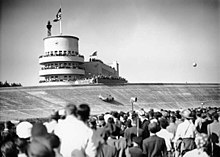
The Automobil-Verkehrs- und Übungsstraße, known as AVUS, is a public road in Berlin, Germany. Opened in 1921, it was also used as a motor racing circuit until 1998. Today, the AVUS forms the northern part of the Bundesautobahn 115.
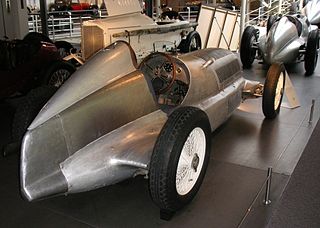
Silver Arrows is a nickname typically given to silver racing cars with a significant connection to a German car manufacturer. Although the term was coined in 1932, it came into popular usage regarding Germany's dominant Mercedes-Benz and Auto Union Grand Prix motor racing cars between 1934 and 1939. The name was later applied to the Mercedes-Benz Formula One and sports cars in 1954 and 1955, then to the Sauber Group C prototype racing sports cars that raced at Le Mans in the late 1980s as well as the McLaren-Mercedes Formula One cars of the late 1990s and 2000s, and is currently applied to the Mercedes-AMG Petronas F1 cars from 2010 to present.

Otto Wilhelm Rudolf Caracciola was a racing driver from Remagen, Germany. He won the European Drivers' Championship, the pre-1950 equivalent of the modern Formula One World Championship, an unsurpassed three times. He also won the European Hillclimbing Championship three times – twice in sports cars, and once in Grand Prix cars. Caracciola raced for Mercedes-Benz during their original dominating Silver Arrows period, named after the silver colour of the cars, and set speed records for the firm. He was affectionately dubbed Caratsch by the German public, and was known by the title of Regenmeister, or "Rainmaster", for his prowess in wet conditions.
The 1954 Formula One season was the eighth season of FIA Formula One motor racing. It featured the 1954 World Championship of Drivers, and several non-championship races. The World Championship of Drivers was contested over a nine-race series which commenced on 17 January and ended on 24 October 1954. The championship was won by Juan Manuel Fangio, who drove, and won races for both Maserati and Mercedes-Benz throughout the series. Argentine drivers gained the first two positions in the championship, with José Froilán González placing second to his compatriot Fangio.

Hermann Albert Lang was a German racing driver who raced motorcycles, Grand Prix cars, and sports cars.
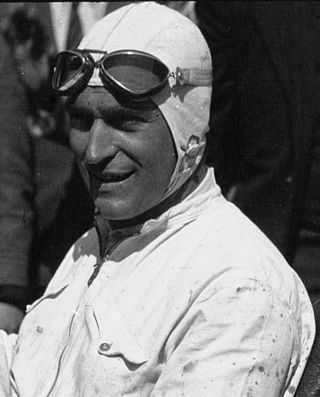
Luigi Cristiano Fagioli, nicknamed "the Abruzzi robber", was an Italian motor racing driver. Having won his last race at 53 years old, Fagioli holds the record for the oldest Formula One driver to win a race. He is also the only Formula One Grand Prix winner born in the 19th century, and the only Grand Prix racing driver to have won a championship race in both the AIACR European Championship and the World Drivers' Championship.
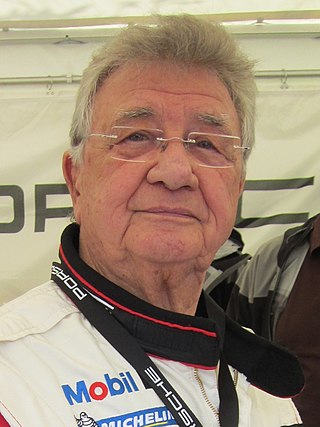
Hans Herrmann is a retired Formula One and sports car racing driver from Stuttgart, Germany.
The European Drivers' Championship was an annual competition in auto racing that existed prior to the establishment of the Formula One world championship in 1950. It was established in 1931 and ran until the end of 1939 with a hiatus from 1933–34, and awarded points to drivers based on the results of selected Grand Prix races, the so-called Grandes Épreuves. The championship was discontinued because of the outbreak of World War II in 1939, and no champion was officially declared for the last season.

The Mercedes-Benz W125 Rekordwagen was an experimental, high-speed automobile produced in the late 1930s. The streamlined car was derived from the 1937 open-wheel race car Mercedes-Benz W125 Formel-Rennwagen, of which also a streamlined version was raced at the non-championship Avusrennen in Berlin.

The Mercedes-Benz W125 was a Grand Prix racing car produced by German auto manufacturer Mercedes-Benz to race during the 1937 Grand Prix season. Designed by head designer Rudolf Uhlenhaut, the car was used by Rudolf Caracciola to win the 1937 European Championship and W125 drivers also finished in the second, third and fourth positions in the championship.
The 1937 Grand Prix season was the fifth AIACR European Championship season. The championship was won by Rudolf Caracciola, driving for the Mercedes-Benz team. Caracciola won three of the five events that counted towards the championship.

The Mercedes-Benz W196 was a Formula One racing car produced by Mercedes-Benz for the 1954 and 1955 F1 seasons. Successor to the W194, in the hands of Juan Manuel Fangio and Stirling Moss it won 9 of 12 races entered and captured the only two world championships in which it competed.

Rudolf Uhlenhaut was a British-German engineer, driving engineer for Mercedes-Benz, and the father of Mercedes-Benz 300 SL and 300 SLR. He had a long association with the Mercedes-Benz racing programme of the 1930s and 1950s, and is best known for his road legal Uhlenhaut Coupé version of the 1955 Mercedes-Benz 300SLR race car.
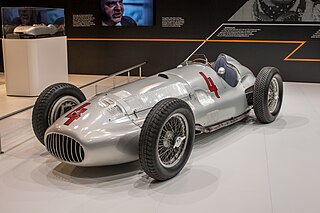
The Mercedes-Benz W154 was a Grand Prix racing car designed by Rudolf Uhlenhaut. The W154 competed in the 1938 and 1939 Grand Prix seasons and was used by Rudolf Caracciola to win the 1938 European Championship.

The Auto Union Grand Prix racing cars types A to D were developed and built by a specialist racing department of Auto Union's Horch works in Zwickau, Germany, between 1933 and 1939, after the company bought a design by Dr. Ferdinand Porsche in 1933. The Auto Union type B streamlined body was designed by Paul Jaray.
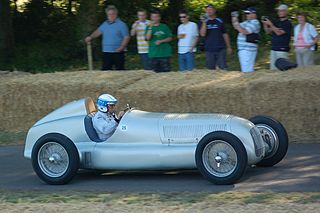
The Mercedes-Benz W25 was a Grand Prix racing car designed by Daimler-Benz AG for the 1934 Grand Prix season, in which new rules were introduced, and no championship was held. In 1935, the European Championship was resumed, and it was won by Rudolf Caracciola in a W25. In modified form, the W25 remained in use until 1937, when it was succeeded by the Mercedes-Benz W125.

Otto Merz was a German racing driver, chauffeur and mechanic. He was a driver in the motorcade during the 1914 assassination of Archuduke Franz Ferdinand and later won the second running of the German Grand Prix in 1927. He died in a crash during practice for the 1933 Avusrennen in a modified Mercedes SSK on 18 May 1933.
Mercedes-Benz, a brand of the Mercedes-Benz Group, has been involved in Formula One as both team owner and engine manufacturer for various periods since 1954. The current Mercedes-AMG Petronas F1 Team is based in Brackley, England, and possesses a German licence. An announcement was made in December 2020 that Ineos planned to take a one third equal ownership stake alongside the Mercedes-Benz Group and Toto Wolff; this came into effect on 25 January 2022. Mercedes-branded teams are often referred to by the nickname, the "Silver Arrows".

August "Bubi" Momberger was a German racing driver and engineer, who competed in Grand Prix motor racing events for various manufacturers between 1926 and 1934. During the 1934 Grand Prix season – the first season of the infamous Silver Arrows period of German dominance of Grand Prix racing, that would last until the outbreak of WWII – he drove for the Auto Union Rennabteilung, and was the first driver of a Silver Arrows car to take a podium finish in a major race. During the season he took a further second-placed finish, and posted two fastest laps, but worsening arthritis and a deteriorating relationship with the Auto Union team manager forced him into retirement before the end of the year. Following his retirement from racing, Momberger returned to his engineering training and rose steadily through the ranks of the German automobile industry, eventually becoming technical director of the Borgward company's Goliath division in Bremen.
Mercedes-Benz made a series of pre-war supercharged Grand Prix racing engines for their Silver Arrow race cars; between 1934 and 1939. They made two supercharged inline-8 engines; the M25 and M125, and one V12 with two generations; the M154 / M163.

